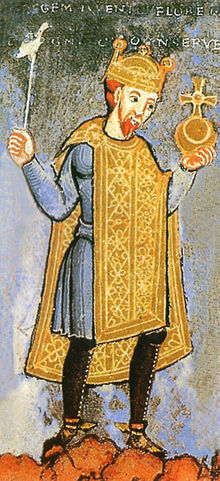
Back Henrique III d'o Sacro Imperio Romano Chermanico AN هنري الثالث (إمبراطور روماني مقدس) Arabic هنرى التالت ARZ Генрых III Чорны Byelorussian Хайнрих III (Свещена Римска империя) Bulgarian Henrik III, car Svetog Rimskog Carstva BS Enric III del Sacre Imperi Romanogermànic Catalan Jindřich III. Černý Czech Henrik 3., tysk-romersk kejser Danish Heinrich III. (HRR) German
| Henry III | |
|---|---|
| Emperor of the Romans | |
 Henry with the symbols of rulership attending the consecration of the Stavelot monastery church on 5 June 1040, mid-11th-century miniature | |
| Holy Roman Emperor | |
| Reign | 25 December 1046 – 5 October 1056 |
| Coronation | 25 December 1046 St. Peter's Basilica, Rome |
| Predecessor | Conrad II |
| Successor | Henry IV |
| King of Germany (formally King of the Romans) | |
| Reign | 14 April 1028 – 5 October 1056 |
| Coronation | 14 April 1028 Aachen Cathedral |
| Predecessor | Conrad II |
| Successor | Henry IV |
| King of Italy and Burgundy | |
| Reign | 4 June 1039 – 5 October 1056 |
| Predecessor | Conrad II |
| Successor | Henry IV |
| Born | 28 October 1016 |
| Died | 5 October 1056 (aged 39) Bodfeld |
| Burial | Imperial Palace of Goslar (heart); Speyer Cathedral (body) |
| Spouses | |
| Issue | |
| House | Salian Dynasty |
| Father | Conrad II, Holy Roman Emperor |
| Mother | Gisela of Swabia |
| Signum manus (1049) |  |
Henry III (German: Heinrich III, 28 October 1016 – 5 October 1056), called the Black or the Pious, was Holy Roman Emperor from 1046 until his death in 1056. A member of the Salian dynasty, he was the eldest son of Conrad II and Gisela of Swabia.[1][2][3]
Henry was raised by his father, who made him Duke of Bavaria in 1026, appointed him co-ruler in 1028 and bestowed him with the duchy of Swabia and the Kingdom of Burgundy ten years later in 1038.[4] The emperor's death the following year ended a remarkably smooth and harmonious transition process towards Henry's sovereign rule, that was rather uncharacteristic for the Ottonian and Salian monarchs.[4] Henry succeeded Conrad II as Duke of Carinthia and King of Italy and continued to pursue his father's political course on the basis of virtus et probitas (courage and honesty), which led to an unprecedented sacral exaltation of the kingship. In 1046 Henry ended the papal schism, was crowned Emperor by Pope Clement II, freed the Vatican from dependence on the Roman nobility and laid the foundation for its empire-wide authority. In the duchies, Henry enforced the sovereign royal right of disposition, thereby ensuring tighter control. In Lorraine, this led to years of conflict from which he emerged victorious. Another sphere of defiance formed in southern Germany from 1052 to 1055. Henry III died, aged only 39. Modern historians, however, identify the final years of his reign as the beginning of a crisis in the Salian monarchy.[5][6]
- ^ Jan Habermann. "The curious story of Henry III". UNESCO World Heritage Centre. Retrieved 1 February 2020.
- ^ "Heinrich III. mit neuem Geburtsjahr". Regesta Imperii - Akademie der Wissenschaften und der Literatur, Mainz. 18 July 2016. Archived from the original on 20 August 2022. Retrieved 1 February 2020.
- ^ Ryley 1964, p. 274.
- ^ a b Rudolf Schieffer (30 September 2013). Christianisierung und Reichsbildungen: Europa 700–1200. C.H.Beck. pp. 150–. ISBN 978-3406653766.
- ^ Friedrich Prinz. "Kaiser Heinrich III. seine widersprüchliche Beurteilung und deren Gründe, in Historische Zeitschrift No. 246 (1988)" (PDF). MGH Bibliothek. Retrieved 15 February 2020.
- ^ Thomas Zotz. "Spes imperii – Heinrichs III. Herrschaftspraxis und Reichsintegration" (PDF). Berlin-Brandenburgische Akademie der Wissenschaften. Retrieved 15 February 2020.